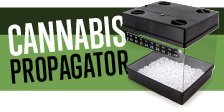Disclaimer
Zativo caters to private customers only, and does not supply commercial or industrial growers with large amounts of cannabis seeds. If we have reason to suspect that the ordered seeds are destined for growing cannabis on a larger-than-private scale, we reserve the right to dismiss that specific order.
Hydroponics
Hydroponic based mediums are popular amongst the more advanced and experienced cultivators. Hydroponic grows are soil-less, they usually involve the use of growth mediums that are flooded with a nutritional solution at regular intervals. These mediums do not possess any nutritional value themselves. Also, they do not buffer the nutritional content passed through them, meaning the roots of your cannabis can get all of the nutrients they need fast and efficiently. However, this also means extra care is needed as it is easy to cause root burn through overfeeding.
Hydroponic setups tend to produce much better results than their soil based counterparts, but costs a lot more money and requires a greater amount of maintenance and expertise. It is usually not recommended for the novice cultivator. However, if you have the money, time and expertise, then we would highly recommend pursuing this for your grow.
So why are hydroponic setups so popular? Well, the advanced control it offers allows experienced cultivators to get bigger buds in about ¾ of the time it would take a soil based grow. That's right, if done correctly you will get more bud in a faster time frame then you would have growing in soil.
The types of hydroponic based mediums
Rockwool
Rockwool is a synthetic substance that resembles modern form of loft insulation. It can be flooded easily during the feeding process and in pliable enough to let roots grow whilst supporting the plant. Prior to its use, rockwool should be soaked in water with a pH level of 5.6 for 24 hours. This is because a lot of rockwool has a high natural pH level and it needs to be brought down. Rockwool can also be baked in the oven for a couple of hours to sterilize it. It use can yield some excellent results, making it a popular choice.
Oasis Cubes
Oasis cubes are very similar to rockwool in use and features, they are just made of a different substance. Before use, oasis cubes should be completely soaked in water and never allowed to fully dry out throughout the entire grow. They are very easy to obtain and much like rockwool, oasis cubes can get very good results.
Expanding clay pellets
Often referred to as “grow rocks” this cannabis growing medium is often the most favored. It is an ecologically sustainable medium compromising of small clay pellets that have been cooked in a kiln. You may be thinking “but I just read you article on soil based mediums, isn’t clay a terrible medium to use?”, well, when clay is baked at high temperatures in a kiln it changes; it becomes more porous in nature, making it a good absorbent artificial grow medium for the use in hydroponics, their ability to retain moister will make sure that your cannabis' roots stay moist in between watering phases. They are also, pH neutral and are great for supporting the stem of your marijuana plants.
Expanding clay pellets are reusable, this a great advantage if you do not want to be constantly buying new supplies. In order to prepare them for your next crop, simply soak the pellets in a gallon of water mixed with 10ml of hydrogen peroxide for a few minuets, followed by drying them out.
Expanding clay pellets can be quite expensive when compared to other hydroponic growth mediums, but are a wise investment in the long run due to their re-usability.
Coconut fiber
Coconut fiber has some great benefits. It has natural root in hormones that encourage healthy root growth in your cannabis plants. It also offers a higher resistance to fungal infestation and root disease than other hydroponic grow mediums. Coconut fiber also retains a lot of the moisture that is passed through it, meaning the roots of your weed are less likely to dry out between watering phases.
When bought, coconut fiber will often come in dried and compressed cubes. When re-hydrated they will expand to around 8-9 times their original size. Before use it must be rehydrate to a consistency that resembles wet, ground coffee - it will look a lot like mulch.
Perlite
Perlite is a silicon-based rock that has a high capacity for water retention. It is a natural form of glass that is inert and has a pH level of 7. It can obtain great results when used both by itself or as a mix with another growing medium.
Vermiculite
Vermiculite is “hydrated laminar magnesium-aluminum-iron-silicate”. During its production process it is placed under extreme heat where it can expand up to 30 times its original size . This expansion makes it great for moisture and nutrient retention. It can be used effectively both by itself and as part of a mixed substrate.
Soil-less mix
These can be either made manually or come pre-packaged from a shop. They are normally made up of composted tree bark, coconut fiber, perlite, vermiculite, peat, silica sand and quartz. Exactly what the composition ratios are can be determined from looking at the mix's packet. A lot of cultivators prefer to make their own, as it is cheap and offers a greater deal of control. The mix offers a great, easy to flood growing medium that has ideal drainage but still retains enough moisture to keep you roots from drying out.




